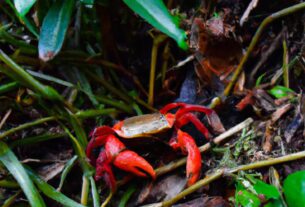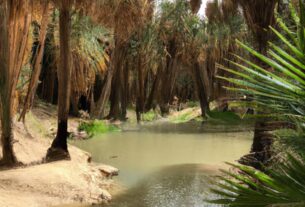Lakes have always fascinated us with their breathtaking beauty, and their colors are nothing short of mesmerizing. Among these captivating hues, blue stands out as one of the most alluring and enchanting shades. The blue color of a lake can range from a delicate baby blue to a deep navy blue, captivating our senses and leaving us in awe of nature’s wonders.
Unveiling the Science behind Blue Lake Color
Have you ever wondered why some lakes appear blue? The secret lies in the interplay between water and light. When sunlight passes through the Earth’s atmosphere, it scatters and appears as white light. However, as sunlight reaches the surface of a lake, it journeys through the water, getting absorbed by water molecules. Interestingly, water molecules primarily absorb light in the red, orange, and yellow spectrums, allowing only green, blue, and violet to reflect back. This phenomenon gives the lake its distinctive blue appearance, leaving us captivated by its beauty.
Factors that Shape the Color of a Lake
The color of a lake is influenced by various factors, such as the depth of the water, the angle of the sunlight, and the presence of sediment or algae. The deeper the water, the more light it absorbs, resulting in darker shades of blue. Furthermore, the angle of the sunlight, especially during sunrise or sunset, can produce mesmerizing reflections on the lake’s surface, further enhancing its color palette.
Sediment and algae also play a significant role in shaping the color of a lake. While sediment can cause the water to appear murky, certain types of algae can give it a greenish hue. Interestingly, blue-green algae can even produce a color that closely resembles blue. Understanding these factors enables us to appreciate the science behind blue lake color and emphasizes the importance of preserving our precious natural resources.
The Significance of Blue Lakes in Tourism
Blue lakes serve as major attractions for tourists worldwide, contributing significantly to local economies. These natural wonders draw millions of visitors each year, who come to indulge in activities like swimming, fishing, and boating. For instance, Lake Tahoe in California, USA, with its crystal-clear blue waters, lures over three million tourists annually. Likewise, Lake Louise in Canada, renowned for its captivating blue color, captivates visitors from across the globe. These lakes not only provide economic benefits but also raise awareness about environmental conservation.
The Ecological Impact and Benefits of Blue Lakes
Blue lakes contribute immensely to the ecosystem, offering a habitat for diverse aquatic plants and animals. Their clear waters allow sunlight to penetrate deeper, promoting the growth of aquatic vegetation that, in turn, provides essential oxygen, food, and shelter for fish and other aquatic life. Moreover, the blue color of a lake often signifies a healthy ecosystem with low levels of pollution and sedimentation. Preserving the blue color of lakes is, therefore, crucial for maintaining the natural balance, protecting the environment, and safeguarding our invaluable natural resources.
Exploring the World’s Famous Blue Lakes
The world is blessed with numerous captivating blue lakes, each with its unique story and allure. Let’s delve into the charm of some of the most famous blue lakes and unravel the secrets behind their distinct colors:
Crater Lake, Oregon, USA
Located in Oregon, USA, Crater Lake holds a prominent place among the world’s famous blue lakes. It came into existence over 7,000 years ago when the colossal eruption of Mount Mazama caused the mountain to collapse, forming a deep caldera. Over time, this caldera filled with water, resulting in the formation of Crater Lake.
The intense blue color of Crater Lake can be attributed to its remarkable depth and clarity. It plummets over 1,900 feet, making it the deepest lake in the United States and the ninth deepest globally. The absence of inflowing streams and rivers prevents sediment from entering the lake, ensuring its unparalleled clarity.
Lake Tekapo, New Zealand
Located in the South Island of New Zealand, Lake Tekapo is another blue lake that leaves visitors spellbound. Its turquoise-blue color is a result of rock flour suspended in the water. Glaciers grind rocks into a fine powder known as rock flour, which is then carried into the lake by rivers, giving the water a milky appearance. The sunlight reflecting off these rock flour particles imparts the lake its mesmerizing blue hue. Lake Tekapo is also renowned for its astounding surroundings, encompassing the Southern Alps and the iconic Church of the Good Shepherd.
Lake Louise, Canada
Situated in Banff National Park, Canada, Lake Louise boasts crystal-clear blue waters that are nothing short of a visual masterpiece. The reflection of light off surrounding glaciers contributes to its unique blue-green color. The glaciers grind rocks into a fine powder, which merges with the meltwater and creates the enchanting blue-green shade that defines Lake Louise.
As one of the most photographed lakes in Canada, Lake Louise attracts tourists from all corners of the world. Surrounded by majestic mountain ranges, it offers an array of outdoor activities such as hiking and skiing, creating an experience that stays etched in one’s memory forever.
Preserving the Blue Color of Lakes – Our Responsibility
Preserving the captivating blue color of lakes is our shared responsibility, ensuring the perpetuity of their beauty and ecological significance. Here are some ways in which we can contribute to this cause:
Reduce Pollution
Pollution poses a severe threat to lakes, diminishing their blue color and degrading their quality. Proper waste disposal, minimizing the use of harmful chemicals, and preventing runoff from entering lakes are vital steps in reducing pollution and preserving their pristine beauty.
Prevent Erosion
Erosion is another factor contributing to the degradation of lakes. Planting vegetation, building retaining walls, and minimizing soil disturbance can effectively prevent erosion, safeguarding the blue color and overall ecosystem of lakes.
Support Conservation Efforts
Supporting conservation organizations through donations, volunteering, and advocacy goes a long way in protecting our natural resources and preserving the blue color of lakes. Organizations like the World Wildlife Fund and the Nature Conservancy actively work towards safeguarding the environment and promoting sustainable practices.
By collectively taking these steps, we can celebrate and preserve the captivating beauty of blue lakes for future generations. As TooLacks, we embrace the responsibility of educating the public on the significance of preserving our natural resources and supporting environmental conservation efforts. Together, let us cherish and protect our blue lakes, safeguarding the wonders of nature for all to enjoy.


